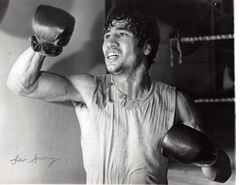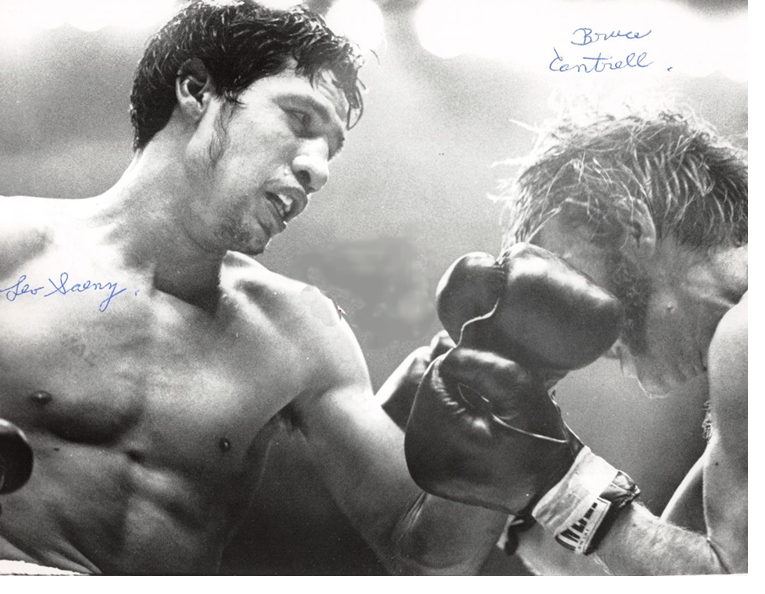The Rolls-Royce of Boxing: Catching Up With “Kid” Leo Saenz
Off in the distance in "The Greatest City in America" you can hear impatient drivers laying on the horn as your shirt is drenched in sweat from the concrete jungles heat radiating off of your brow. There’s trash lining the street and neon signs advertising for what essentially amounts to the cities red light district for anyone brave enough to venture into this part of town. The seedy streets of Baltimore are home to a particularly rough and tumble breed of city slicker who possess their own verbiage complete with a garbled northern accent to boot. It’s a morally corrupt place where little hope exists for the downtrodden outside of a life spent hustling on the street.
A real life “Rocky” on the block to the hang around's and those who knew him best at the height of his professional boxing career, Leo “Kid” Saenz was a hero who offered hope to the decidedly average among us. A colorful personality who bears the scars of a career spent in the ring; Saenz just smiles and says “thank you” when I inadvertently mention that he is the real fucking deal in passing.
 “I gotta knock him out, I gotta knock him out,” remembers trainer Terry Moore in the March 4th, 1974 Sports Illustrated article titled, “On the Block: Way of All Flesh," by author John Schulian. “Leo, you already done punched holes in the man," replied Moore. "He said, ‘I know, but I gotta knock him out.’” Described as “relentlessly aggressive” and as “always hunting them,” Saenz is one of the best fighters to ever come out of Baltimore, Maryland.
“I gotta knock him out, I gotta knock him out,” remembers trainer Terry Moore in the March 4th, 1974 Sports Illustrated article titled, “On the Block: Way of All Flesh," by author John Schulian. “Leo, you already done punched holes in the man," replied Moore. "He said, ‘I know, but I gotta knock him out.’” Described as “relentlessly aggressive” and as “always hunting them,” Saenz is one of the best fighters to ever come out of Baltimore, Maryland.
“‘This guy,’ says Eli (Hanover) of the kid, ‘is the best fighter I’ve seen in the past 30 years potential-wise. If he don’t become a champion, it’s because he didn’t try. He can be what you’d call the Rolls-Royce of boxing.’” Although Saenz was the #10 ranked middleweight in the world according to the March 1977 issue of Ring magazine, today “Kid” is far removed from the world of professional boxing though he still looks back on his career in the ring with pride and fond memories.
Reversing the sands of time to offer a small glimpse of what the middleweight picture looked like back in the mid to late 1970s, according to a May 9th, 2007 BrickCityBoxing.com article titled, “’Gloves Gone By’: Casey Gacic,” author Jim Amato writes that, “Gacic bounced back with two decision wins and then he outfought rugged Leo Saenz as part of the controversial United States Tournament. Eight months later Casey was outscored by another undefeated prospect Edgar ‘Bad News’ Wallace. In 1978 Casey returned to Cleveland as he won a points verdict over Charles Carey. Then it was back to Madison Square Garden where Casey took on contender Mike Baker.”
“During the summer of 1976, King, an instinctive reader of trends, noticed the national enthusiasm for America’s boxing team at the Montreal Olympics,” explains author Jack Newfield in his 1995 book titled, “The Life and Crimes of Don King: The Shame of Boxing in America,”
According to Newfield, “King sensed the upsurge in nationalism and patriotism as five Americans won gold medals for the first time, including Sugar Ray Leonard and the Spinks brothers. Leon and Michael. The notion of organizing a tournament to crown an American champion was in the air.”
Interestingly, according to the book, “On July 30, King sent Ring magazine a $10,000 check 'to alleviate expenses incurred in preparing the ratings of the many fighters that will be participants in the tournament.'”
“Also,” writes Newfield, “King contrived to have as many white fighters as possible in the tournament, knowing their commercial value, recognizing the commercial success of the film Rocky. When some at ABC questioned the ability of these white fighters, like Bill Cline (Chris’s son), Pat Dolan, Tom Prater, John Sullivan and Casey Gacic, King’s rebuttal was always ‘The public wants to see fights between white and black fighters,’ which was certainly true.”
Reflecting on his fight with Gacic, according to Saenz, “They robbed me. I think he was with what’s his name, who’s that big guy down in California with the hair sticking out? Don King. He came back,” remembers Saenz. “They robbed me. They robbed me. Hey, listen!” shouts Saenz over top of me as he senses I'm about to ask some follow up questions. “Don King came up to my dressing room and gave me $18,000… in cash. Cold cash.”
“For what?” I asked somewhat rhetorically. “What did he give you the money for?”
 “Because they robbed me,” replied Saenz. “Everybody yelled out, ‘What? No way. Leo didn’t lose that fight.’” Reflecting on the match, “I knocked him three times in twelve rounds,” said Saenz. “I knocked him down three times and I beat the hell out of him. And I still got robbed."
“Because they robbed me,” replied Saenz. “Everybody yelled out, ‘What? No way. Leo didn’t lose that fight.’” Reflecting on the match, “I knocked him three times in twelve rounds,” said Saenz. “I knocked him down three times and I beat the hell out of him. And I still got robbed."
“I said, ’Well, thank you. You know I won that fight, right?’” recalls Saenz in response to the $18,000 King gifted him after the fight. “$18,000 shuts somebodys mouth up. So, that’s what happened,” explained Saenz.
Mike Baker, an interesting character in his own right from this now long forgotten era in boxing history went on to compile, “a pro record of 52-19-3 with 32 knockouts,” explains author Robert Neely in his April 7, 2001 GoupState.com article titled, “Carolinas Boxing Hall of Fame inducts Baker.” According to the report, “Baker beat Leo Saenz for the United States junior middleweight title in 1975, holding it for two years, and had a world title fight in London. Baker was a boxer, but he spent three years under contract to the NFL’s Washington Redskins.”
Interestingly, Saenz fought Baker twice. Once on February 22, 1975, where he lost to Baker for the United States junior middleweight title. However, they re-matched just two months later in April of 1975 where Saenz defeated Baker by unanimous decision.
A former golden gloves tournament winner out of Grand Rapids, Michigan who in his amateur days once defeated the All-Army boxing champion, Saenz is a member of the Maryland Boxing Hall of Fame who has been in the ring with some of the greatest fighters of all-time to include the legendary Emile Griffith (85-24-2, 23 KOs) who Saenz fought to a decision loss.
An Apache indian who is not only descended from the legendary Geronimo but also related to the great John Wayne himself, Saenz has carved out his own legacy as one of the best fighters to ever come out of Baltimore. “I love Josh Hall, don’t get me wrong,” remembers Saenz as we watch back on an ESPN Classic piece together featuring his former promoter Eli Hanover and the old Baltimore city gym he use to train out of. “But he didn’t have it in him. He didn’t have it in him like me. I had it in me. I was an ass kicker,” admits Saenz. “They said, they said, ‘Why does Leo go in the ring and it looks like somebody is trying to kill him?’ Because they were. They were trying to hit me in the head and I’m not going to let them.”
Street certified with a gravelly voice very much reminiscent of a gangster of the sea, Saenz is a throwback to a bygone era of Baltimore city boxing that has long since given way to the sands of time. A hero to the downtrodden and to those left behind, today Saenz is living proof that even those from the humblest of beginnings can become a professional success. With the likes of Gervonta “Tank” Davis now carrying the gauntlet for Baltimore city boxing, the storied history of the city’s pugilistic excellence is sure to continue long into the future as legendary fighters like Leo “Kid” Saenz remain testaments to exactly what kind of fighters are produced from the "The Greatest City in America."





